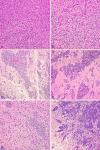Rat brain tumor models in experimental neuro-oncology: the C6, 9L, T9, RG2, F98, BT4C, RT-2 and CNS-1 gliomas
- PMID: 19381449
- PMCID: PMC2730996
- DOI: 10.1007/s11060-009-9875-7
Rat brain tumor models in experimental neuro-oncology: the C6, 9L, T9, RG2, F98, BT4C, RT-2 and CNS-1 gliomas
Abstract
In this review we will describe eight commonly used rat brain tumor models and their application for the development of novel therapeutic and diagnostic modalities. The C6, 9L and T9 gliomas were induced by repeated injections of methylnitrosourea (MNU) to adult rats. The C6 glioma has been used extensively for a variety of studies, but since it arose in an outbred Wistar rat, it is not syngeneic to any inbred strain, and its potential to evoke an alloimmune response is a serious limitation. The 9L gliosarcoma has been used widely and has provided important information relating to brain tumor biology and therapy. The T9 glioma, although not generally recognized, was and probably still is the same as the 9L. Both of these tumors arose in Fischer rats and can be immunogenic in syngeneic hosts, a fact that must be taken into consideration when used in therapy studies, especially if survival is the endpoint. The RG2 and F98 gliomas were both chemically induced by administering ethylnitrosourea (ENU) to pregnant rats, the progeny of which developed brain tumors that subsequently were propagated in vitro and cloned. They are either weakly or non-immunogenic and have an invasive pattern of growth and uniform lethality, which make them particularly attractive models to test new therapeutic modalities. The CNS-1 glioma was induced by administering MNU to a Lewis rat. It has an infiltrative pattern of growth and is weakly immunogenic, which should make it useful in experimental neuro-oncology. Finally, the BT4C glioma was induced by administering ENU to a BD IX rat, following which brain cells were propagated in vitro until a tumorigenic clone was isolated. This tumor has been used for a variety of studies to evaluate new therapeutic modalities. The Avian Sarcoma Virus (ASV) induced tumors, and a continuous cell line derived from one of them designated RT-2, have been useful for studies in which de novo tumor induction is an important requirement. These tumors also are immunogenic and this limits their usefulness for therapy studies. It is essential to recognize the limitations of each of the models that have been described, and depending upon the nature of the study to be conducted, it is important that the appropriate model be selected.
Figures

References
-
- Krushelnycky BW, Farr-Jones MA, Mielke B, et al. Development of a large-animal human brain tumor xenograft model in immunosuppressed cats. Cancer Res. 1991;51:2430–2437. - PubMed
Publication types
MeSH terms
Grants and funding
LinkOut - more resources
Full Text Sources
Other Literature Sources
Medical
Research Materials

